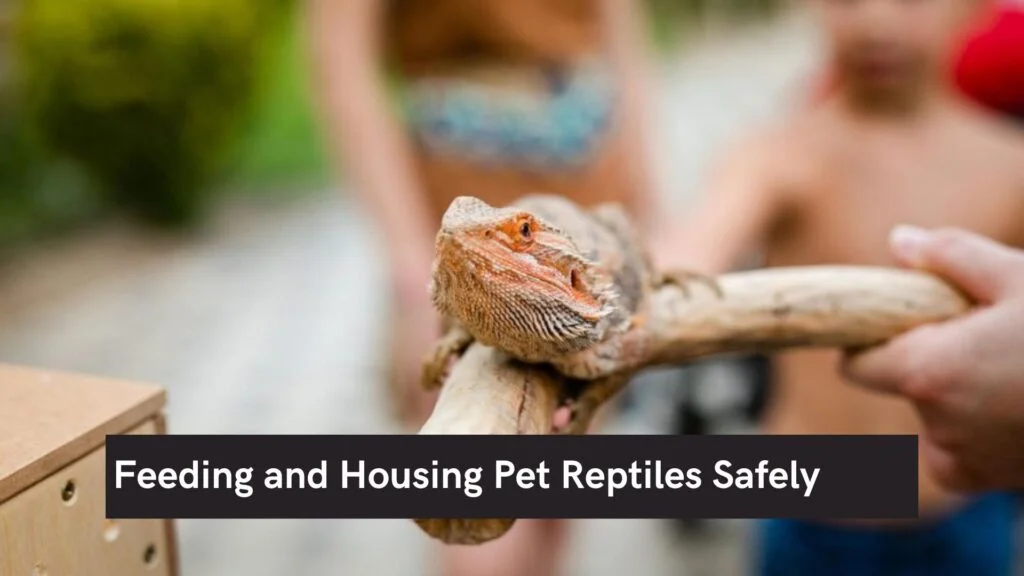Feeding and Housing Pet Reptiles Safely. A lot of reptiles display nervousness and insecurity when they are in enclosure. This may be diminished by exposure to appropriate terrarium furnishings and concealing places. Feeding and housing pet reptiles properly is essential to meet their natural behaviors and ensure their well-being. To guarantee extra safety, a black border painted on the glass wall 20 cm beneath the ground of the terrarium should be introduced to some species. Other reptile species are territorial and prefer being kept in a solitary cage.
With the experience gained, reptile owners can design a terrarium in order to keep several compatible species. Social and day-active species are very communal in housing so it may be necessary to have multiple basking to feeding to drinking sites not readily visible to other conspecifics or even human watchers. Aggressive species might also require separation during the feeding to enable them to avoid hurting their cage mates. Inter-Species fighting can dramatically decrease by having species that co-exist alone in houses.
Floors of the Enclosure Bought to be lined with cost-effective

non-poisonous and non-shedding, discard-able safeguard. Snakes have successfully been kept on newspaper, sand, moss, topsoil, wood shaving, cypress bark shaving, corncob bedding, hickory bedding, gravel, alfalfa grains and artificial turf. It is not advisable using cedar shaving because the odors and fumes are toxic to the respiratory system, and even the nerve tissues.
Snakes less than 18 inches (46 cm) in length should not be fed on loose substrates (shavings, corncob bedding, hickory bedding and small gravel) since they collect around the mouth (and may result in oral swelling) and are capable of being ingested (and can result in an intestinal obstruction).
Less Complicated Substrate Preferred It is easier to clean

The most desirable substrate to be used with sick reptiles is newspaper which is undeniably cheap, clean and the regurgitated material or droppings can be easily observed. The substrate is also determined by the required humidity level of a certain reptile. Cypress mulch can retain moisture and do not mould. On the other hand, corncob beddings are easily accessible but are costly and get molded seriously when wet. Peats, soil, moss, and sand formations keep the humidity and permit to burrow. A drier medium can also be used such as sand or soil.
Microclimates inside an enclosure could give higher humidity variants without high humidity levels in the whole terrarium. Many species of lizards turtles and tortoises can use sand, topsoil and dead leaves as bedding. Abundant rabbit food, alfalfa, grains (also known as common rabbit pellets), also make helpful bedding used by tortoises and tortoises. The pellets are cheap, easy to clean and nutritious – provided they are consumed! The gravel must be big to avoid ingestion.
Lighting Needs

The full-spectrum light works well to boost reptile feeding behavior, activity and, relatively less reproduction as it has features similar with normal sunlight and contains ultraviolet rays. Optimum lighting in the reptile enclosures is fluorescent bulbs that emit UVB units of 290 to 320 nanometers wavelengths.Ultraviolet light can also be obtained with mercury vapor lamps. To have healthy reptile skin it is vital to provide the right ultraviolet spectrum.
Ordinary sources of UV lights are to be located within 45 cm of a basking or basking zone whereas mercury vapor lamps may be located several meters away. A black light used with full-spectrum bulbs possibly induces reproductive behavior of lizards; however, it has no noticeable effects on the exposure of ultraviolet B (UVB) light.
Water Adaptations of Semi-Aquatic Reptiles

Semi-aquatic reptile, which originates and develops in water as well in its vicinity, has to be capable of complete immersion. Most species feed, reproduce and socialize under water. Salt level in the water should be regulated with care in case of salt water species. The pH of water to other species of aquatic turtles might require adjustment to that of the natural environment. The requirements of water are associated with the sources of water in the natural habitat of a reptile.
Availability of water at all times is very important to curb dehydration. Most of the species can easily drink puddle water or in bowls, but there are some small species of lizard (e.g. anoles and the true chameleons) that utilize the water vapour condensed water droplets by licking. There are possibilities to drink some water: mist the environment or build a drip system. Consult your veterinarian or person taking the reptile/s to find out how to adequately keep your reptile hydrated.
